| Listing 1 - 10 of 43 | << page >> |
Sort by
|
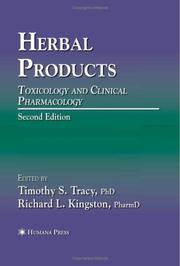
ISBN: 1280971835 9786610971831 1597453838 1588293130 Year: 2007 Publisher: Totowa, N.J. : Humana Press,
Abstract | Keywords | Export | Availability | Bookmark
 Loading...
Loading...Choose an application
- Reference Manager
- EndNote
- RefWorks (Direct export to RefWorks)
Herbal Products: Toxicology and Clinical Pharmacology, Second Edition builds upon the informative foundation laid by its predecessor. This fully revised and expanded second edition boasts over 200 new references that document efficacy studies and adverse effects and four new chapters devoted to dietary products. Practitioners and researchers will find that this volume is a comprehensive resource for objective clinical information about the potential uses, efficacy, and safety of herbal medicines. The authors recognize that the majority of available information on dietary supplements is typically provided by distributors and designed to sell a product rather than objectively inform consumers; therefore, the emphasis throughout is on information not readily available from any other source. Similar to the first edition, this volume is based on original studies published in peer-reviewed journals, as well as meta-analyses, systematic reviews, and other high-quality assessments by recognized experts.
Herbs --- Materia medica, Vegetable --- Toxicology. --- Botanical drugs --- Drugs from plants --- Medicinal plants --- Phytotherapy --- Plant drugs --- Vegetable drugs --- Materia medica --- Botanical drug industry --- Botany, Medical --- Plants, Useful --- Forbs --- Therapeutic use
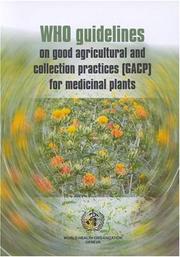
ISBN: 9241546271 1417531177 9786610088539 1280088532 9240681590 Year: 2003 Publisher: Genève Organisation mondiale de la Santé
Abstract | Keywords | Export | Availability | Bookmark
 Loading...
Loading...Choose an application
- Reference Manager
- EndNote
- RefWorks (Direct export to RefWorks)
Medicinal plant materials are supplied through collection from wild populations and cultivation. Under the overall context of quality assurance and control of herbal medicines, WHO developed the Guidelines on good agricultural and collection practices (GACP) for medicinal plants, providing general technical guidance on obtaining medicinal plant materials of good quality for the sustainable production of herbal products classified as medicines. These guidelines are also related to WHO's work on the protection of medicinal plants, aiming promotion of sustainable use and cultivation of medicinal plants. The main objectives of these guidelines are to:. (1) contribute to the quality assurance of medicinal plant materials used as the source for herbal medicines to improve the quality, safety and efficacy of finished herbal products;. (2) guide the formulation of national and/or regional GACP guidelines and GACP monographs for medicinal plants and related standard operating procedures; and. (3) encourage and support the sustainable cultivation and collection of medicinal plants of good quality in ways that respect and support the conservation of medicinal plants and the environment in general. These guidelines concern the cultivation and collection of medicinal plants and include certain post-harvest operations. Good agricultural and collection practices for medicinal plants are the first step in quality assurance, on which the safety and efficacy of herbal medicinal products directly depend. These practices also play an important role in protection natural resources of medicinal plants for sustainable use.
Drug plants --- Geneeskrachtige planten --- Medicinal plants --- Planten [Geneeskrachtige ] --- Plantes médicinales --- Plants [Drug ] --- Plants [Medicinal ] --- Plants, Useful --- Botanical drug industry --- Botany, Medical --- Materia medica, Vegetable --- Psychotropic plants --- Medicinal plants. --- Plants, Useful. --- Useful plants --- Plants --- Plants and civilization --- Botany, Economic
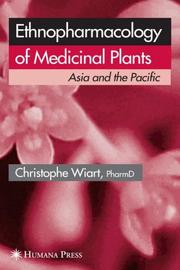
ISBN: 1588297489 9786610832477 1280832479 1597451606 Year: 2006 Publisher: Totowa, N.J. : Humana Press,
Abstract | Keywords | Export | Availability | Bookmark
 Loading...
Loading...Choose an application
- Reference Manager
- EndNote
- RefWorks (Direct export to RefWorks)
In 1860, Oliver Wendell Holmes pointedly expressed himself to the Massachusetts Medical Society: “I firmly believe that if the whole Material Medica, as now used, could be sunk to the bottom of the sea, it would be all the better for mankind, and all the worst for the fishes.” Should one think the same about the current approach in drug discovery from plants? Probably yes. Despite the spending of billions of US dollars, and three decades of efforts, high-throughput screenings have only allowed the discovery of a couple of drugs. One could have reasonably expected the discovery of an arsenal of drugs from the millions of plant extracts randomly tested, but “hits” can be inactive in vitro or too toxic, some molecules need to be metabolized first to be active, and false-positive and false-negative results are common. The bitter truth is that the robotic approach in discovering drugs from plants has proven, to date, its inability to excavate the hundreds of molecules that will contribute to the health progress of Man. However, one can reasonably see that the last patches of primary rainforest on earth hold still hundreds of spectacularly active drugs that await discovery.
Materia medica, Vegetable --- Ethnopharmacology --- Indigenous peoples --- Botanical drugs --- Drugs from plants --- Medicinal plants --- Phytotherapy --- Plant drugs --- Vegetable drugs --- Therapeutic use --- Pharmacy. --- Pharmacology. --- Pharmacology/Toxicology. --- Ethnoscience --- Pharmacology --- Traditional medicine --- Materia medica --- Botanical drug industry --- Botany, Medical
Periodical
ISSN: 23221399 25883739 Year: 2012 Publisher: Tehran, Iran : Iranian Medicinal Plants Society,
Abstract | Keywords | Export | Availability | Bookmark
 Loading...
Loading...Choose an application
- Reference Manager
- EndNote
- RefWorks (Direct export to RefWorks)
phytochemistry --- biosynthesis --- extraction methodology --- Microbiological activity --- Plant breeding --- Medicinal plants --- microbiological activity --- plant breeding --- Medicinal plants. --- Drug plants --- Plants, Useful --- Botanical drug industry --- Botany, Medical --- Materia medica, Vegetable --- Psychotropic plants
Periodical
Abstract | Keywords | Export | Availability | Bookmark
 Loading...
Loading...Choose an application
- Reference Manager
- EndNote
- RefWorks (Direct export to RefWorks)
medicinal --- aromatic --- plants --- aromatherapy --- Medicinal plants --- Aromatic plants --- Aromatic plants. --- Medicinal plants. --- Drug plants --- Plants, Useful --- Botanical drug industry --- Botany, Medical --- Materia medica, Vegetable --- Psychotropic plants --- Plants --- Essences and essential oils --- Flowers --- Fragrant gardens --- Odor
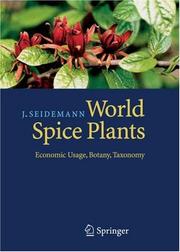
ISBN: 3540279083 3540222790 3642060889 Year: 2005 Publisher: Berlin : Springer,
Abstract | Keywords | Export | Availability | Bookmark
 Loading...
Loading...Choose an application
- Reference Manager
- EndNote
- RefWorks (Direct export to RefWorks)
This book addresses the need to disseminate scientific knowledge of the complex world of spice plants to a wide audience of interest. It considers the economic usage of spices in several forms, as an ingredient for adding flavor, as a pot herb and as an additive for condiments such as ketchup, and mustard. Designed as a work of reference, it offers an easy to use systematic listing of international nomenclature. The book is aimed primarily at aroma experts in both science and industry, but also botanists, pharmacists, food chemists and dieticians will take inspiration from the book, which is also illustrated by around 100 full color photographs. - Comprehensive listing of over 1400 plants - Plant nomenclature from around the world - Arranged alphabetically for ease of reference - Exhaustive register of relevant literature for further reading.
Spice plants. --- Spice plants --- Materia medica, Vegetable. --- Geographical distribution. --- Composition. --- Botanical drugs --- Drugs from plants --- Medicinal plants --- Phytotherapy --- Plant drugs --- Vegetable drugs --- Materia medica --- Botanical drug industry --- Botany, Medical --- Plants, Edible --- Therapeutic use --- Pharmacy. --- Botany. --- Plant Sciences. --- Botanical science --- Phytobiology --- Phytography --- Phytology --- Plant biology --- Plant science --- Biology --- Natural history --- Plants --- Chemistry --- Medicine --- Drugs --- Pharmacology --- Plant science. --- Floristic botany
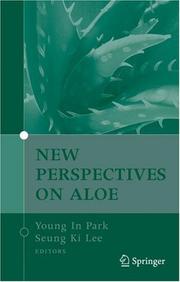
ISBN: 128063443X 9786610634439 0387346368 0387317996 1441940693 Year: 2006 Publisher: New York ; Berlin : Springer,
Abstract | Keywords | Export | Availability | Bookmark
 Loading...
Loading...Choose an application
- Reference Manager
- EndNote
- RefWorks (Direct export to RefWorks)
New Perspectives on Aloe will cover research studies of aloe by the CAP (Creation Aloe Pharmaceuticals) team, which studied various aspects of aloe over a period of more than 10 years. The team was organized into two groups: the isolation and analysis group, which purified many components in terms of low molecular weight compounds, carbohydrates, proteins present in aloe, and the assay group, which determined the efficacy of those components. This type of target-oriented, organized research provides a model of how to conduct multidisciplinary research. The contents include a brief introduction of aloe, isolation, purification, and structural analysis of components, and various physiological effects of those components for possible use as health foods or drugs. Various functions identified were wound healing, angiogenesis, anti-allergy, skin whitening, stimulation of cell proliferation such as liver or kidney, protection against nephrotoxicity, and immune modulation. Moreover, we suggest standardization and quality control procedures for manufacturing raw aloe, and how to develop related products for successful application of aloe. This is important in Korea because last year the Korean government listed aloe as a health food for which the government establishes regulatory laws. Therefore, many scientists in Korea who are interested in studying health foods would be interested in this kind of text. Other major fields related to this kind of research will be medicine, biology, pharmaceutics, natural products and analytics.
Aloe --- Medicinal plants. --- Therapeutic use. --- Drug plants --- Plants, Useful --- Botanical drug industry --- Botany, Medical --- Materia medica, Vegetable --- Psychotropic plants --- Aloes --- Aloinella --- Guillauminia --- Lemeea --- Asphodelaceae --- Toxicology. --- Pharmacology/Toxicology. --- Chemicals --- Medicine --- Pharmacology --- Poisoning --- Poisons --- Toxicology --- Pharmacology. --- Drug effects --- Medical pharmacology --- Medical sciences --- Chemotherapy --- Drugs --- Pharmacy --- Physiological effect
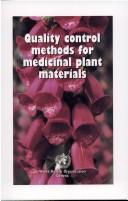
ISBN: 9241545100 Year: 1998 Publisher: Geneva World Health Organization
Abstract | Keywords | Export | Availability | Bookmark
 Loading...
Loading...Choose an application
- Reference Manager
- EndNote
- RefWorks (Direct export to RefWorks)
Pharmacognosy --- Applied chemical analysis --- Chemical tests and reagents --- Medicinal plants --- Quality control --- Drug plants --- Chemical reagents --- Reagents, Chemical --- Factory management --- Industrial engineering --- Reliability (Engineering) --- Sampling (Statistics) --- Standardization --- Quality assurance --- Quality of products --- Plants, Useful --- Botanical drug industry --- Botany, Medical --- Materia medica, Vegetable --- Psychotropic plants --- Indicators and test-papers
Periodical
Abstract | Keywords | Export | Availability | Bookmark
 Loading...
Loading...Choose an application
- Reference Manager
- EndNote
- RefWorks (Direct export to RefWorks)
Materia medica, Vegetable --- Phytotherapy --- Medicinal plants --- Materia medica, Vegetable. --- Medicinal plants. --- Drug plants --- Botanical drugs --- Drugs from plants --- Plant drugs --- Vegetable drugs --- Therapeutic use --- Plants, Useful --- Botanical drug industry --- Botany, Medical --- Psychotropic plants --- Materia medica --- Fitoteràpia --- Plantes medicinals --- Fitoteràpia. --- Plantes medicinals.
Periodical
Abstract | Keywords | Export | Availability | Bookmark
 Loading...
Loading...Choose an application
- Reference Manager
- EndNote
- RefWorks (Direct export to RefWorks)
Pharmacognosy --- Medicinal plants --- Research --- Pharmacognostics --- Pharmacognosy. --- Phytotherapy --- Herbal Therapy --- Herb Therapy --- Pharmacognosies --- Medicinal plants. --- Drugs --- Materia medica --- Pharmacy --- Drug plants --- Plants, Useful --- Botanical drug industry --- Botany, Medical --- Materia medica, Vegetable --- Psychotropic plants --- Materia Medica --- Plant Extracts --- Plants --- Plants, Medicinal --- Ethnobotany --- Ethnopharmacology --- Herbal Medicine --- Medicine, Mongolian Traditional --- Medical Marijuana --- Flower Essences --- Medicine, Traditional --- Phytotherapy. --- Health Sciences --- Pharmacy and Pharmacology --- Pharmacy, Therapeutics, & Pharmacology
| Listing 1 - 10 of 43 | << page >> |
Sort by
|

 Search
Search Feedback
Feedback About UniCat
About UniCat  Help
Help News
News